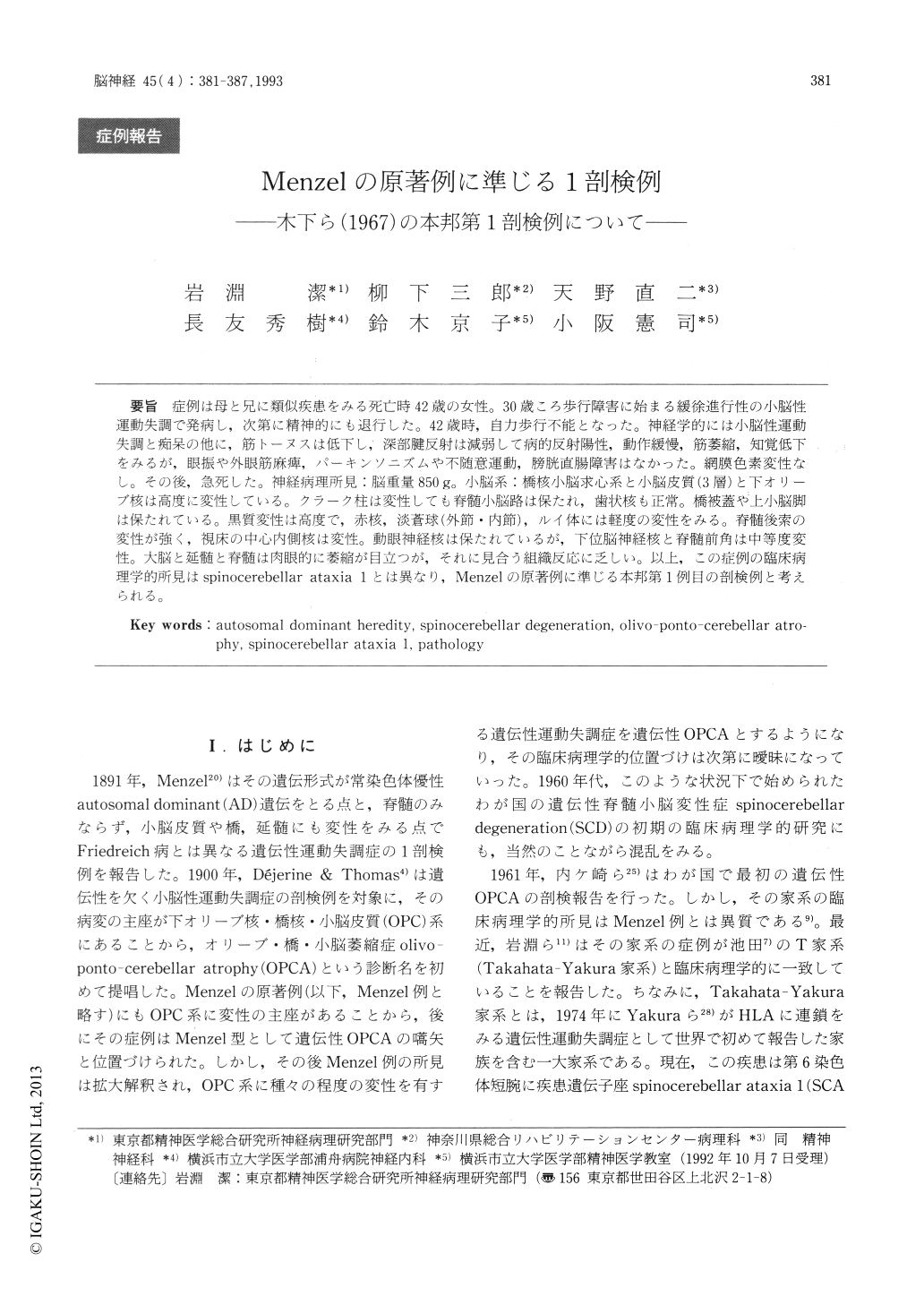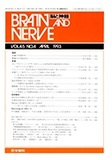Japanese
English
- 有料閲覧
- Abstract 文献概要
- 1ページ目 Look Inside
症例は母と兄に類似疾患をみる死亡時42歳の女性。30歳ころ歩行障害に始まる緩徐進行性の小脳性運動失調で発病し,次第に精神的にも退行した。42歳時,自力歩行不能となった。神経学的には小脳性運動失調と痴呆の他に,筋トーヌスは低下し,深部腱反射は減弱して病的反射陽性,動作緩慢,筋萎縮,知覚低下をみるが,眼振や外眼筋麻痺,パーキンソニズムや不随意運動,膀胱直腸障害はなかった。網膜色素変性なし。その後,急死した。神経病理所見:脳重量850g。小脳系:橋核小脳求心系と小脳皮質(3層)と下オリーブ核は高度に変性している。クラーク柱は変性しても脊髄小脳路は保たれ,歯状核も正常。橋被蓋や上小脳脚は保たれている。黒質変性は高度で,赤核,淡蒼球(外節・内節),ルイ体には軽度の変性をみる。脊髄後索の変性が強く,視床の中心内側核は変性。動眼神経核は保たれているが,下位脳神経核と脊髄前角は中等度変性。大脳と延髄と脊髄は肉眼的に萎縮が目立つが,それに見合う組織反応に乏しい。以上,この症例の臨床病理学的所見はspinocerebellar ataxia lとは異なり,Menzelの原著例に準じる本邦第1例目の剖検例と考えられる。
We report a patient whose clinicopathological findings are compatible with those of the case repor-ted by Menzel in 1891. This case was briefly report-ed by Kinoshita et al in 1967 as hereditary ataxia of Menzel type. But the concept of this disease has been confused, especially in the early investigations for the hereditary olivo-ponto-cerebellar atrophy (OPCA) in Japan. The Kinoshita's patient should be considered as the first Japanese case whose findings are identical with Menzel's report. This report re-presents a precise study of the case reported by Kinoshita et al.
The patient was a 42-year-old Japanese woman. Her mother and one of her brothers suffered from the same disease. She began to experience progres-sive ataxia at the age of 30. At age 42, she was admitted to another hospital because of inability to walk and mental deterioration. Neurological exami-nation revealed cerebellar ataxia in the extremities and trunk, childish personality change, dementia, diminished deep tendon reflexes with extensor plantar response bilaterally, slowness and hypo-kinesia in the movement, generalized muscular atrophy, and sensory disturbance prominent in deep sensory. She has no involuntary movement and dysautonomia. She had no retinal degeneration, nystagmus, nor progressive nuclear oculomotor palsy. She died of pneumonia. Neuropathological findings revealed brain weight of 850g. The brain was very small, but there were no paticular changes in the cerebral cortex and white matter histologica-lly. The cerebellar systems showed a marked dege-neration in the cerebellar cortex including the mole-cular, Purkinje cells, and granular cells layers, the pontine basis including the pontine transverse fibers, the middle cerebellar peduncles, the cerebellar white matter, and in the inferior olivary nuclei. However, the dentate nuclei were spared. In spite of a marked cell loss in the Clarke's column of the thoracic spinal cord, the anterior-and posterior-spinocerebellar tracts appeared normal. In the extrapyramidal system, there were a marked degenration in the substantia nigra and from a slight to moderate degeneration in the red nucleiand external segment of the globus pallidus. The striatum was spared. The oculomotor nuclei and medial longitudinal fasciculi were preserved. A moderate neuronal loss was observed in the motor neuclei of the lower cranial nerves and the anterior horn of the spinal cord. The spinal dorsal column including both Goll's and Burdach's fasciculi was severely degenerated.
Recent progress has revealed the heterogenety of hereditary OPCA. Neuropathology of the presentpatient was different from that of hereditary OPCA, the gene locus of which exists in the short arm of choromosome 6p (spinocerebellar ataxia 1 (SCA 1)) . However, the clinico-pathological findings of the present case were identical with those of Andoh:s case (1991) and Cuban hereditary OPCA whose family member showed the gene locus did not exist in the chromosome 6p.

Copyright © 1993, Igaku-Shoin Ltd. All rights reserved.


